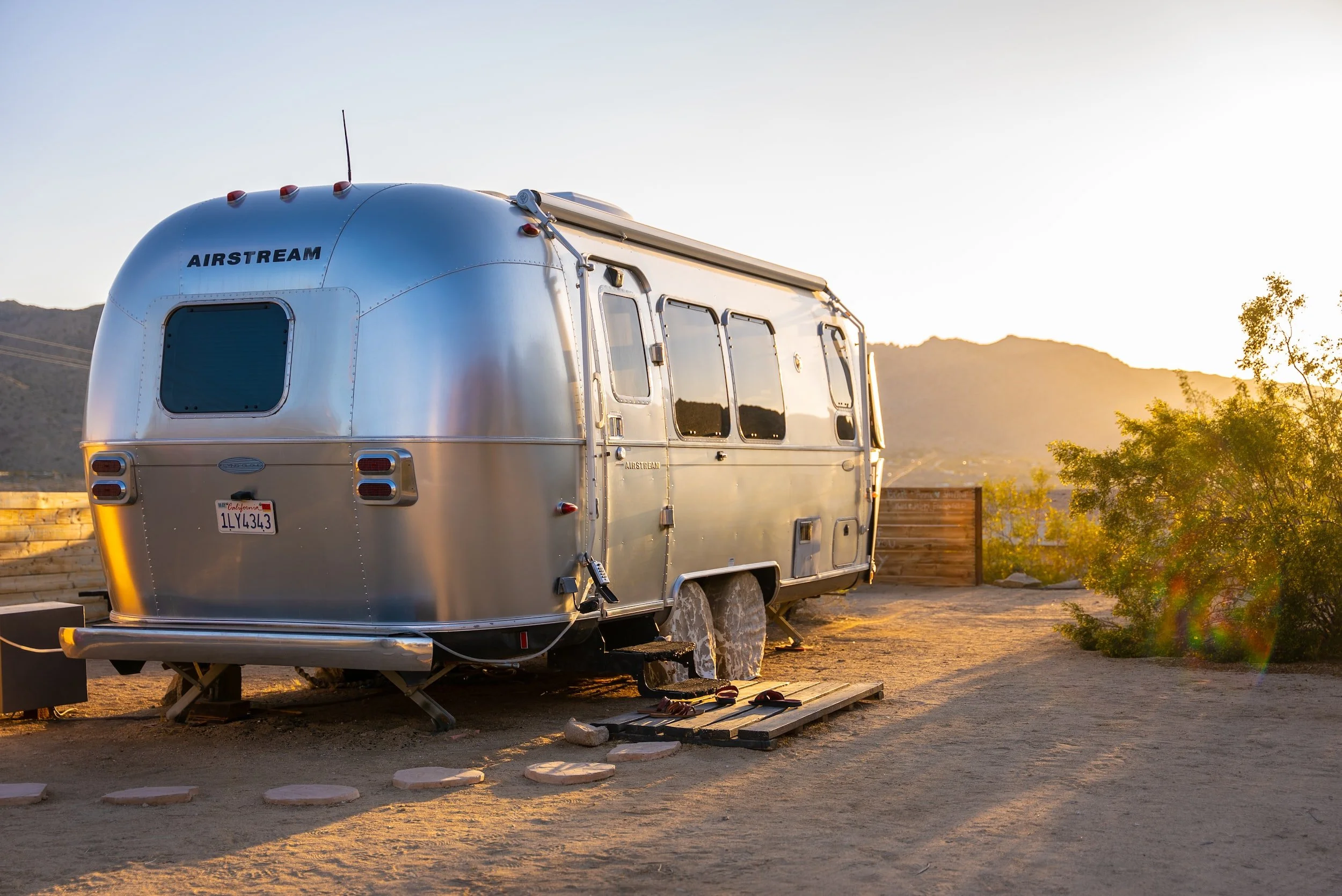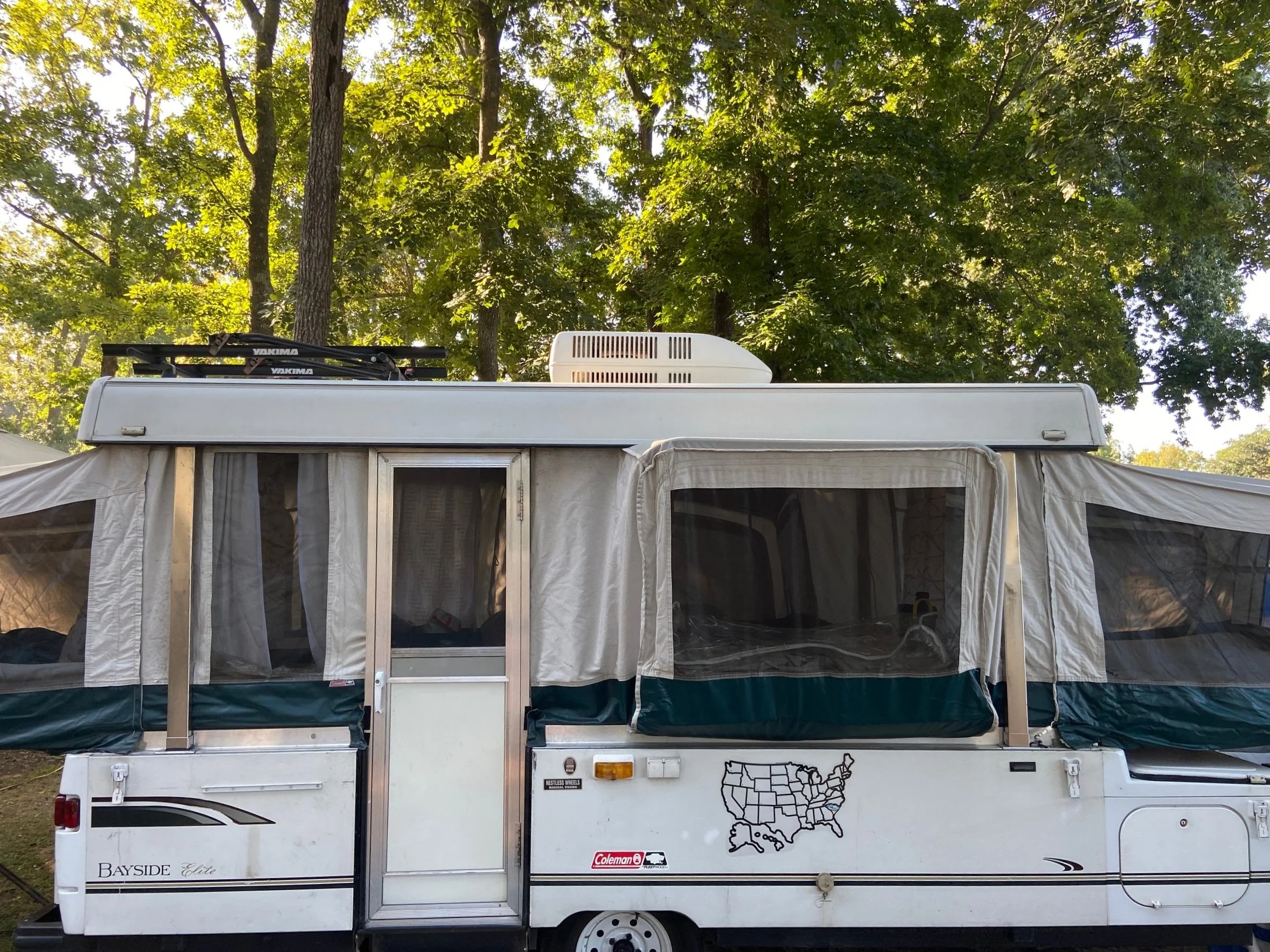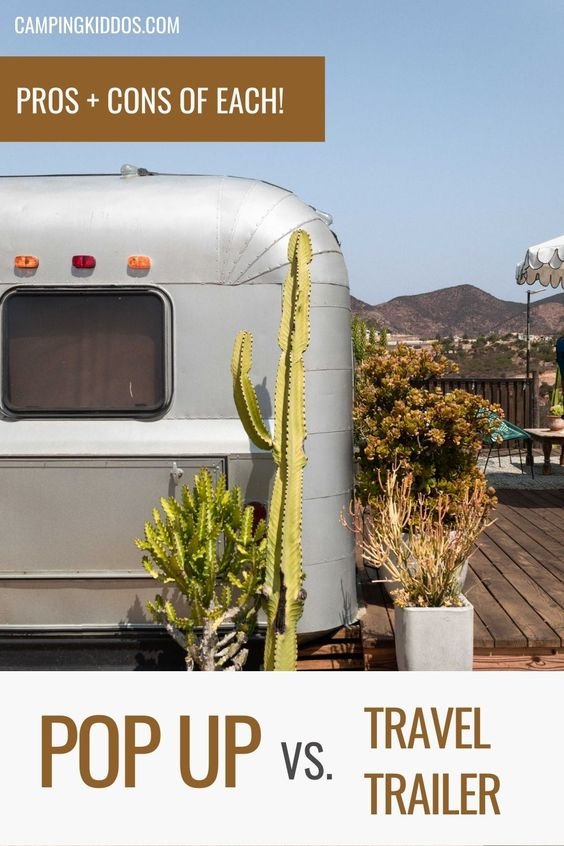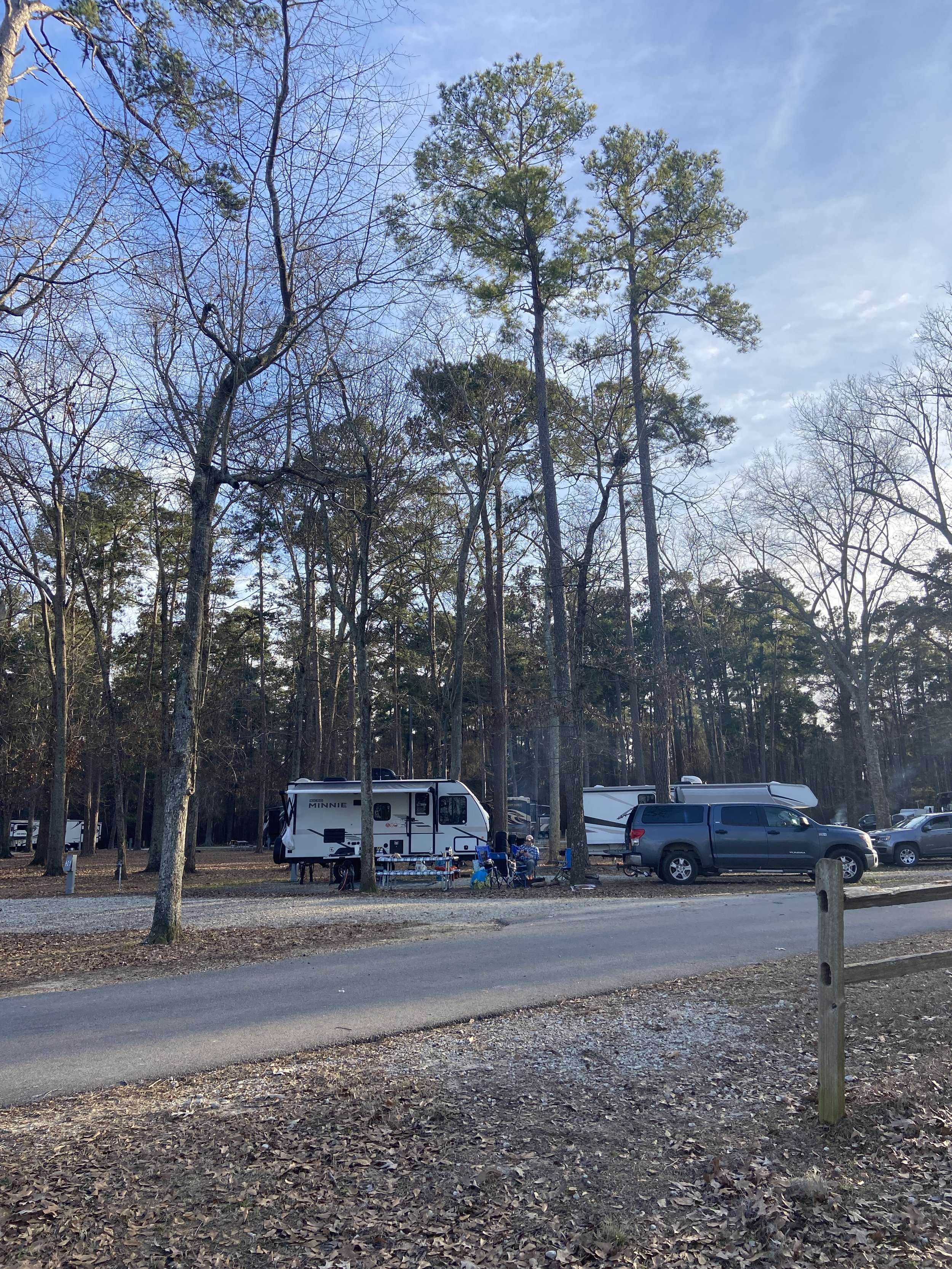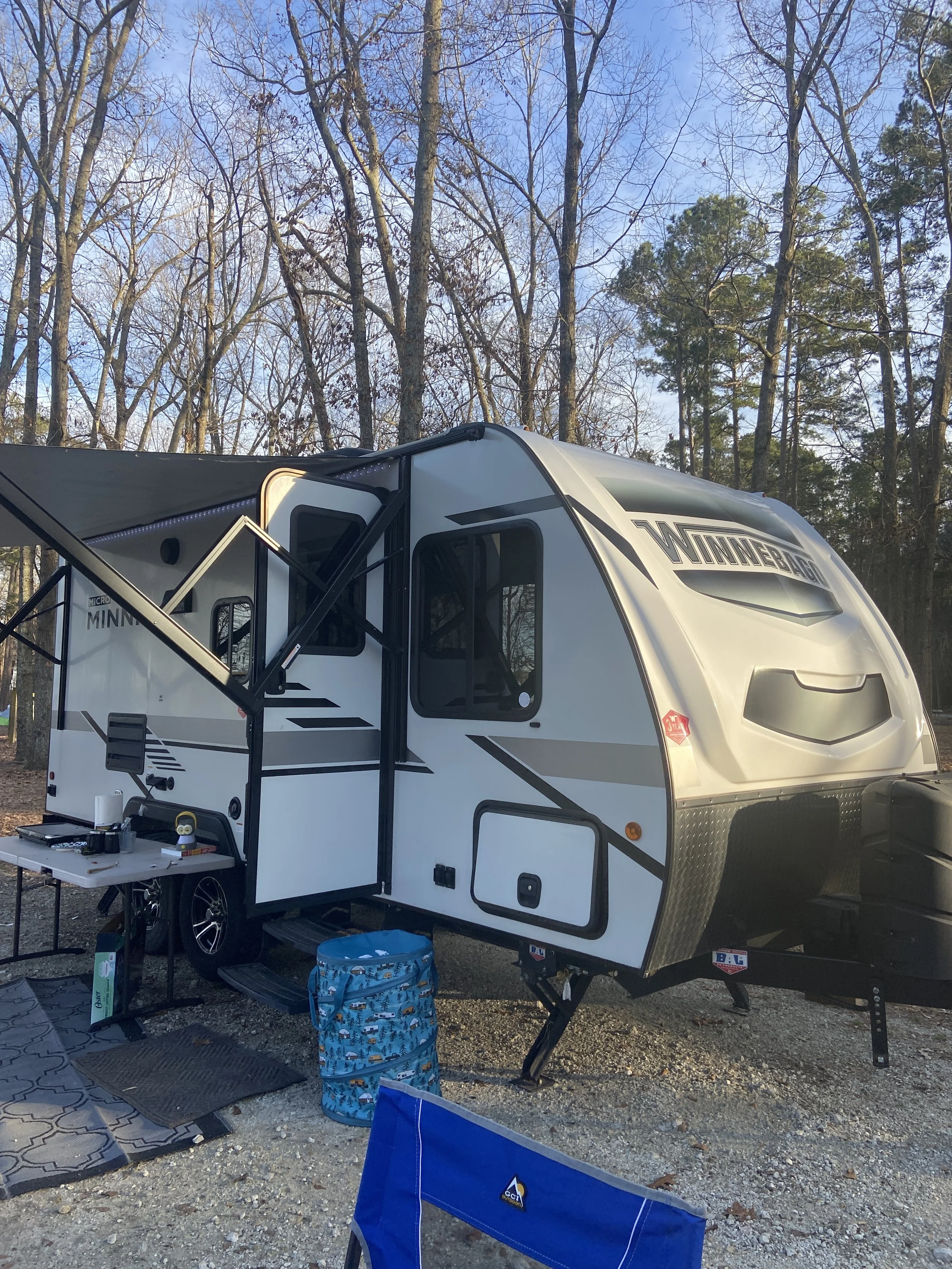Pop Up Camper vs. Travel Trailer
If your family wants to take your camping experience to the next level, you’re probably weighing the pros and cons of a pop up camper vs. a travel trailer.
Each of these popular pull-behind camping options could be the perfect fit for making more family memories, but you’ll want to carefully consider your unique needs, travel style, and cost.
My family has had both a pop-up camper and a travel trailer over the last 5 years, and we’ve loved each for different reasons.
Here are our key takeaways on each type of camper, and why each might be best for your next big camping purchase.
Why Should You Get a Pop up Camper?
Our trusty 2002 Coleman Bayside Elite at a Myrtle Beach campground
When we first made the decision to upgrade from tent camping to trailer camping, we settled on a pop up camper.
This decision seemed obvious as a pop up camper is essentially a tent on wheels!
If you haven’t been in a pop up camper, it generally has 2 large beds that are suspended off of each end of the trailer, and then a small living and dining space in the middle.
CAMP LIKE A PRO: When researching a new RV park or planning a cross-country road trip, I can’t recommend the RV Life app enough.
I can plan out routes that are safe for my specific trailer, get recommendations on favorite gas station locations (hello, Buc-ees), see points of interest on my route, and get detailed reviews from fellow campers.
Best $59 I’ve spend on an app!
Pros of a Pop Up Camper
Pop ups are smaller than travel trailers. Our pop up, a 2002 Coleman Bayside Elite, measured about 19 feet from back bumper to the tip of the tongue.
PIN ME!
This means that we were able to maneuver easily into gas stations and parking lots.
The pop up fit easily in our garage in between trips, and we never had any issues about fitting into any campground space.
Which leads into my next pop up camper pro…
Pop ups can be pulled by smaller trucks, vans, and SUVs.
Depending on the Gross Vehicle Weight Rating (GVWR) that your vehicle can handle, you might not need to upgrade anything to tow your pop up.
Our 2002 Coleman Bayside Elite pop up camper weighed around 2500 pounds (before we added cargo to it), so it was an easy haul for our Toyota Sequoia and Toyota Tundra.
Most, if not all, vans, SUVs, and trucks will be able to handle a tow trailer at that size; even some larger cars can handle it!
Pop ups generally sleep 6 people comfortably.
Despite the overall small footprint of the camper, the pop up allowed us to sleep 6 people: 2 on each of the king beds and another 2 on the queen bed (that was converted from the dining table).
If you have a larger family, this set up could be ideal as you could easily sleep 2-3 smaller kids on each of the king beds!
It’s also great if you travel often with other family members or friends who need sleeping space.
The pop up has all of the amenities of a larger trailer.
Hot water, shower, toilet, sink, and 2 burner stove: pop ups have all of this and more!
Even on an older model like our pop up, you’ll find everything you need for a great night of glamping.
Many pop ups—especially newer models—also have features like power stabilizers, power jack, outdoor kitchens, and television hookups.
We loved having the feeling of tent camping with the upgrade of A/C, heat, and easy on-site cooking.
When you’re ready to take the leap into pop up ownership, check out my pop up camper buying guide for the questions you need to ask before purchasing.
Enjoying the gorgeous fall foliage in mid-November at Oconee State Park, Walhalla, South Carolina
Cons of a Pop Up Camper
The soft sided tents don’t handle extreme temperatures well.
When we’d camp in 50-75 degree weather, the pop up camper was glorious.
Waking to the sound of birds and watery sunlight through the tent sides was incredibly peaceful.
However, once the temperatures starting dipping towards freezing or rose above 85 or so, the pop up camper struggled to keep us comfortable.
We’re not scared of 4 season camping (which, living in the mild weather of South Carolina, isn’t hard!), and we can always pile on more clothes for the cold, or offset our sweating with lots of water.
However, the pop up camper is much harder to regulate when the temperatures outside go outside of that “perfect camping weather.”
We went camping at Oconee State Park in the Appalachian mountains in mid-November a few years back, and the temps dipped well below freezing for 3 nights of our trip.
We came prepared with beanies, extra blankets, and Hot Hands, but we counted too strongly on the propane to offset the chill in the air at night.
Our propane went out halfway through the trip at 4 AM, and we were chilly!
On the flip side, on a trip to Pigeon Forge in late June, we were lucky enough to get record breaking temperatures that soared into the triple digits.
Our poor A/C couldn’t keep up, and the temperature inside of the tent stayed in the mid-90s all day.
If you’re used to tent camping, you won’t get any relief in this department with a pop up.
In fact, we felt that the pop up got less air flow than a typical tent, which only exacerbated the temperature issues.
Learn how to keep your dogs warm while camping with these easy tips!
The single axel doesn’t distribute weight well.
For a smaller trailer, a single axel is standard. However, you have to be really careful about how to distribute the weight inside of the camper while en route.
It can be tempting to shove everything in the empty space inside the camper, but the best course of action is to put the heaviest stuff in the front storage compartment (if your pop up has one).
Pop up tires are notorious for popping en route.
I learned this lesson the hard way!
During our camping trip to the Outer Banks, I had a tire pop on the way there AND on the way back.
There’s nothing that will throw off your day like changing a trailer tire on the side of a busy highway, hoping that the other drivers have chosen that moment to focus on the road.
Pop up camper tires are small—only 13”—and they are very cheaply made.
You can buy them at a hardware store, so they’re in a different class than a bigger tire you’d get from a regular tire shop.
The tendency of pop up camper tires to blow is so common that I’ve even seen it referred to as “a rite of passage” on several camper forums!
Plan ahead, keep new-ish tires on your trailer, and always have a fresh spare.
You’ll have more peace of mind carrying a 3-ton trailer jack as well, which was invaluable to us when the worst happened.
Set up and break down can be a chore.
This was my least favorite thing about a pop-up: after we’d driven several hours to a destination, I still had at least an hour of work more to do.
Since the entire trailer folds down compactly for travel, you then have to crank up the ceiling, pull out the beds, make the beds, set up the dining room table, and get all of the couch pillows out.
That’s on top of the usual camp arrival stuff like getting the water, sewer, and electricity hooked up, pulling the chairs, outdoor rugs, and tables out, leveling the camper, and putting down the stabilizers.
I usually was exhausted by the time dinner rolled around on that first day.
Our older pop up was fully manual, so cranking the ceiling, putting down the stabilizers, and pulling out/propping up the beds was all done by hand.
New models have more automatic/electrically driven components, but you’ll still have plenty of stuff to do with a pop up before you can sit down and relax by the fire.
>> Plan your next trip with my recommendations for the best state parks in South Carolina for camping! <<
Why Should You Get a Travel Trailer?
Our Winnebago travel trailer at Santee State Park in South Carolina
We’ve recently upgraded to a hard sided travel trailer, a 2020 Winnebago Micro Minnie 1800BH.
While it was sad to send our pop up off to a new owner, we wanted to try something new in camper ownership.
Neither my husband nor I had ever owned a travel trailer camper, but we were excited to learn about it, and compare it to our experiences with the pop up.
Here’s what we’ve discovered!
Pros of a Travel Trailer Camper
Set up/break down is a breeze.
When we first took our Winnebago Micro Minnie out to a campground, I worked for about 15 minutes unhooking our camper from the tow vehicle, and hooking into the electricity and water.
Then, I looked around and wondered what I’d missed!
After the intense set up with our pop up, the set up (and breakdown) with the travel trailer is down right simple.
Plus, we have power jacks and power stabilizers which makes the process even easier.
This simple set up and break down also allows us to easily boondock for the night, like when we use free stays at Cracker Barrel, Cabela’s, Walmart, or the like.
That wouldn’t have been an option in the pop up!
>> Read my full review of our Winnebago Micro Minnie 1800BH here. <<
Interested in boondocking at a big box store? Check out my guide to overnight RV parking at Cabela’s!
Temperature regulation is easy.
While travel trailers are full on glamping, that upgrade does come with more guaranteed comfort.
Those hard sides aren’t as thick as those in an actual house, but they are much more effective against heat and cold than our pop-up was.
A camping trip in January saw temps in the upper 30s at night, and we slept warm and comfy with our furnace set to 65.
You don’t hear as much inside the camper.
Those thicker walls also help with noise, so you won’t hear your neighbor’s dog barking all night as we did once in our pop-up at Lakewood Camping Resort!
Read my full Lakewood Camping Resort in Myrtle Beach, South Carolina, review.
You’ll be in good company in the campgrounds.
When you settle into your campground, you’ll notice that most of the vehicles there are hardsided: Class C’s, Class A’s, fifth wheels, and travel trailers.
There just aren’t as many pop-ups as there are travel trailers: if you’re not looking to win a popularity contest, this won’t matter much, however.
Travel trailers tend to be more luxurious than pop-ups.
If you’re someone who likes pretty interiors, high end finishes, and quality cabinetry, you’ll want to consider a travel trailer.
Since travel trailers are made to be covered all of the time, manufacturers can put those finishing touches inside.
This means you could get upgraded curtains, better quality flooring, tile finishes in the kitchen, quiet close cabinets, solar panels, and more.
Pop-ups, however, need to be more weather resistant, so the interiors are basic with fewer upgrades.
If you’re planning to get a travel trailer, you’ll need to check out my list of travel trailer must haves!
Cons of a Travel Trailer Camper
Larger travel trailers won’t fit in all campsites.
Our Winnebago Micro Minnie is only about 2.5’ longer than our pop-up!
We have big plans to tour the US, so we wanted to ensure that our camper fit in all of the national and state parks we might run across.
However, the vast majority of travel trailers are bigger than ours. Many push 35’ in length, which means you’ll need to pay close attention to site dimensions when booking reservations.
Keep in mind that you’ll get much more space inside these longer travel trailers, but you might not be able to fit into some national and state park campgrounds (many of which top out at 26’ for campsite length).
You may need to upgrade your tow vehicle.
Bigger travel trailers need bigger, stronger vehicles to safely get you to your destination.
While our 22’ travel trailer can be pulled by our Toyota Tundra and Toyota Sequoia (both of which have the 5.7L engine), larger travel trailers may need a 3/4 ton or 1 ton truck to effectively and safely pull them.
Unless you already own a dually, a Ram 2500, an F-350 or something similar, you’ll need a smaller travel trailer OR the ability to trade in your current vehicle.
They’re more expensive than pop-up campers.
Adding hard sides to a camper and upgrading the interior fixtures comes at a price. You can buy a used pop-up for anywhere from $1000-8000, depending on the age and quality, but a new travel trailer can set you back $35,000 or more.
Even a brand new Forest River pop-up—coming in around $25,000—is cheaper than most brand new travel trailers.
Carefully consider your budget and compare it against the different sizes, features, and extras available.
For new campers, there is a learning curve.
What’s a grey tank, and how is it different than a black tank? What does my sway bar do? How do I switch over my fridge from propane to electric?
A travel trailer is essentially a tiny house, and it comes with some complicated systems!
While the pop-up can also have these same systems, those systems tend to be smaller and have fewer ways to mess up.
We feel as if we cut our proverbial teeth on campers with the pop-up, as we learned much about these systems before getting our travel trailer.
Just know: you’ll need to Google a million questions before you get everything perfect!
If you’re buying a new travel trailer, request an appointment with your salesperson for an in depth review of all systems and features.
Video tape the appointment if necessary—this makes for a great visual review later when something goes wrong.
I hope that these insights were helpful as you debate pop up campers vs. travel trailers in your own camping journey!
Both have their own fans, and we’ve loved the experience in each.
As long as you carefully consider length, budget, amenities, tow capacity, and features, you’re soon to pick the perfect camping vehicle for your family.
No matter how you camp, don’t forget these items—and download our printable camping packing list!

